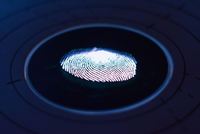Five Popular Authentication Technologies You Should Know About

The more applications and web services people use, the more they should care about their privacy and data security. Hackers have learned to steal business data, personal data, and money using special ransomware and malware. The growing number of fraud, money laundering, data breaches made consumers and businesses think of better means to enhance data protection.
Both businesses and consumers have to improve their knowledge of trending authentication technologies. For enterprises, especially banks, customer data security must become the top priority. Below are the five most popular ways to identify users and customers.
Fingerprint Authentication
The fingerprint is one of the biometrics authentication technologies. One of the brightest examples is Apple’s Touch ID that was introduced with iPhone 5S. Fingerprints have been exploited for many decades in criminal justice and border protection. Today, this technology is used for verifying a person’s identity while he or she wants to access some digital services online.
How does fingerprint scanning work? Fingerprint scans are built into many consumer devices. They use the same technology as touchpads and touch screens. Scanning involves the lower layer of your finger skin and the phone screen.
Unlike passwords, fingerprint identification is securer and faster. It is also one of the most accurate recognition technologies.
Voice Recognition
Voice authentication systems have become popular among many industries, including e-commerce, banking, healthcare, education, etc. This technology can also be used to make it possible for the healthcare automation solution to identify Parkinson’s symptoms early.
How does it work to verify identity? Once a person articulates his or her request, the authentication system should recognize the voice and match the request to the respective account. Thus, a customer support representative doesn’t need to check the client’s personal information to reply to the request.
Although this type of biometric identification is considered safe, there are still cases when the voice can be copied. For example, in 2017, a BBC reporter managed to fool the system. He has mimicked his twin brother’s voice and accessed his banking account. So, many security specialists recommend combining voice recognition with other types of authentication.
Face Recognition
Compared to fingerprint, face authentication has a lower error rate. Facial recognition is being implemented in many industries. Some devices use it to provide access. Governments in some countries of the world use it to verify driving licenses, for instance. In Japan, for example, banks implement facial recognition technology into ATMs as a security measure to verify transactions.
So, how does it work? Faces differ in many specific factors like the distance between the eyes or the width of the nose. Facial recognition systems look at up to 100 face peculiarities to identify unique features. Although this authentication type has become popular, it also has some complications like aging faces or different angles. But these problems are successfully solved by utilizing aging patterns, 2D, and 3D technologies.
Multi-Factor Authentication
Multi-factor authentication (MFA) is aimed to compensate for the drawbacks of multiple separate factors, at least two, which differ in key risks. Two-factor authentication is a method of identifying a user in on the internet by requesting authentication data of two different types, which provides two-layer, and therefore more effective protection of the account from unauthorized entry.
In practice, this usually looks like this: the first line is the username and password, the second is a special code that comes by SMS or e-mail. Rarely, the second “layer” of protection asks for a unique USB key or user’s biometric data. In general, the essence of the approach is very simple: to get somewhere, you need to confirm twice that you are you, and with the help of two “keys”, one of which you own and the other you keep in mind.
For example, a system built on hardware keys can be strengthened by a password. In this case, the scams with the token won’t know the password, and the hacker with the password won’t have the token.
Palm Vein Authentication
Palm recognition is also a biometric type of identity verification. A person should place the hand over the palm sensor. The scanner analyzes and learns the veins’ patterns to recognize those in the future. There is no need to touch the scanner.
The leader in the palm vein technology is the Japanese company called Fujitsu. Its products are used by a certain number of banks in Japan. They use this technology to verify the identity of their customers while sending transactions using ATMs.
How to Prevent Identity Theft: Basic Rules for Internet Users
You see, there are many ways to avoid fraud and data breaches. However, every internet user must be aware of these simple rules to protect themselves from identity theft.
1. Be very attentive when searching for information on the internet.
2. Don’t send your sensitive data via messengers in social networks.
3. Don’t forget to sign out from your social account if you use other people’s devices.
4. Turn off wi-fi if you don’t use it.
5. Don’t use public wi-fi when you send confidential data.
6. Don’t open strange files — they may harm your device or get access to your personal data.
7. Limit access to your personal information.
8. Develop a back-up strategy for essential data.
9. Be careful when sending online payments.
10. Be attentive when making any charity payments.
No matter what type of authentication you prefer or your service provider offer, you should study it first before using. Make sure that you understand how it works, how it protects your data, and how to use it appropriately.

